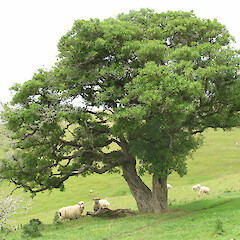Myoporum laetum
Common name
ngaio
Synonyms
Myoporum laetum G.Forst. var. laetum, Myoporum laetum var. decumbens G.Simpson
Family
Scrophulariaceae
Flora category
Vascular – Native
Endemic taxon
Yes
Endemic genus
No
Endemic family
No
Structural class
Trees & Shrubs - Dicotyledons
NVS code
The National Vegetation Survey (NVS) Databank is a physical archive and electronic databank containing records of over 94,000 vegetation survey plots - including data from over 19,000 permanent plots. NVS maintains a standard set of species code abbreviations that correspond to standard scientific plant names from the Ngä Tipu o Aotearoa - New Zealand Plants database.
MYOLAE
Chromosome number
2n = 108
Current conservation status
The conservation status of all known New Zealand vascular plant taxa at the rank of species and below were reassessed in 2017 using the New Zealand Threat Classification System (NZTCS) – more information about this can be found on the NZTCS website. This report includes a statistical summary and brief notes on changes since 2012 and replaces all previous NZTCS lists for vascular plants.
Please note, threat classifications are often suggested by authors when publications fall between NZTCS assessment periods – an interim threat classification status has not been assessed by the NZTCS panel.
- Conservation status of New Zealand indigenous vascular plants, 2017 . 2018. Peter J. de Lange, Jeremy R. Rolfe, John W. Barkla, Shannel P. Courtney, Paul D. Champion, Leon R. Perrie, Sarah M. Beadel, Kerry A. Ford, Ilse Breitwieser, Ines Schönberger, Rowan Hindmarsh-Walls, Peter B. Heenan and Kate Ladley. Department of Conservation. Source: NZTCS and licensed by DOC for reuse under the Creative Commons Attribution 4.0 International licence.
2017 | Not Threatened
Previous conservation statuses
2012 | Not Threatened
2009 | Not Threatened
2004 | Not Threatened
Brief description
Spreading tree bearing glossy yellow-green to dark green heavily spotted oval leaves usually occurring not far from coast. New growth very glossy, dark and sticky. Flowers white with purple spots, at base of leaves. Fruit pink, on a stalk.
Distribution
Endemic. Three Kings, North and South Islands. Also on the Chatham Islands where scarce and probably naturalised.
Habitat
Coastal to lowland forest, sometimes well inland (in Hawke’s Bay, Rangataiki and Wairarapa). Often uncommon over large parts of its range.
Wetland plant indicator status rating
Information derived from the revised national wetland plant list prepared to assist councils in delineating and monitoring wetlands (Clarkson et al., 2021 Manaaki Whenua – Landcare Research Contract Report LC3975 for Hawke’s Bay Regional Council). The national plant list categorises plants by the extent to which they are found in wetlands and not ‘drylands’. The indicator status ratings are OBL (obligate wetland), FACW (facultative wetland), FAC (facultative), FACU (facultative upland), and UPL (obligate upland). If you have suggestions for the Wetland Indicator Status Rating, please contact: [Enable JavaScript to view protected content]
UPL: Obligate Upland
Rarely is a hydrophyte, almost always in uplands (non-wetlands).
Detailed description
Decumbent shrub, shrub, or small tree up to 10 m tall and in decumbent forms 2-4 m across. Trunk to 0.3 m diam. Bark light grey to brown, thick and corky, firm, persistent, rough and furrowed. Branches stout, spreading. Leaf buds dark brown, purple-black to almost black, very sticky. Petioles flattened up to 300 mm long. Leaves somewhat fleshy, yellow-green to green, conspicuously white to yellow gland-spotted, (40-)100-120 x (10-)30-40 mm, lanceolate, oblong-lanceolate, oblong to obovate, acute to acuminate, margins crenulate-serrulate in upper half to third, margins sinuate to plain. Flowers in 2-6-flowered axillary cymes. Peduncles up to 15 mm long. Calyx-teeth 2 mm, narrow-lanceolate, acuminate. Corolla campanulate, white, purple-spotted, 5-lobed, lobes hairy on upper surface. Stamens 4. Fruit a narrow-ovoid drupe, 6-9 mm long, white or pale to dark reddish-purple.
Similar taxa
Ngaio could be confused with Tasmanian boobialla (M. insulare) but is distinct by its serrated, gland-spotted leaves. We include var. decumbens G. Simpson within M. laetum, regarding it as merely one extreme of a continuous range of variation present in the species. Aside from leaf shape and size there are no other distinguishing characters. Another species, M. kermadecense, endemic to the Kermadec Islands, is rarely cultivated in New Zealand, for distinctions see under that species.
Flowering
October - January
Flower colours
Violet/Purple, White
Fruiting
December - June
Propagation technique
Easily grown from fresh seed and semi-hardwood cuttings
Threats
Not threatened. However, in some parts of the country such as urban Auckland, Wellington and along portions of the Kaikoura coast hybrid swams involving Tasmanian boobialla (Myoporum insulare sens. lat.) are common. The widespread planting of Tasmanian boobialla, or hybrids poses a risk to ngaio in places where it is not common.
Etymology
myoporum: Shut pore
laetum: Pleasant
Where To Buy
Commonly cultivated and sold by many garden centres. However, some nursery stock offered as ngaio is either Tasmanian boobialla or hybrids involvying that entity (see features).
Poisonous plant
The leaves contain ngaione which has antibacterial properties but is also toxic to livestock, causing liver damage (Brooker et al., 1998). Click on this link for more information about Poisonous native plants.
Attribution
Fact Sheet prepared for the NZPCN by: P.J. de Lange (22 April 2011). Description based on Allan (1961)
References and further reading
Allan, H.H. 1961: Flora of New Zealand. Vol. I. Wellington, Government Printer.
Brooker, S. G., Cambie, R. C. and R. C. Cooper (1998). New Zealand Medicinal Plants. Reed: Auckland.
NZPCN Fact Sheet citation
Please cite as: de Lange, P.J. (Year at time of access): Myoporum laetum Fact Sheet (content continuously updated). New Zealand Plant Conservation Network. https://www.nzpcn.org.nz/flora/species/myoporum-laetum/ (Date website was queried)

















